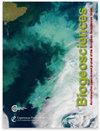碱度和硝酸盐动态揭示了超浑浊河口厌氧氨氧化的优势
IF 3.9
2区 地球科学
Q1 ECOLOGY
引用次数: 0
摘要
摘要总碱度(TA)调节大气CO2的海洋储存能力。在异养温带河口,有机物的厌氧呼吸,例如反硝化作用,可能是TA的重要来源。反硝化是硝酸盐(NO3-)厌氧还原为元素氮(N2)。厌氧氨氧化通过铵(NH4+)和亚硝酸盐(NO2-)的反应生成终端产物N2;然而,这个过程不会释放TA作为副产物。为了研究这两种硝酸盐和亚硝酸盐呼吸途径及其对TA生成的影响,我们在2020年6月流入北海的埃姆斯河高浑浊河口取样。在退潮期间,从瓦登海到潮口上游采样了一个样带,在此采样了流体泥浆进行孵育实验,并在超浑浊潮河中采集了5个垂直剖面。结果表明,潮河中TA和溶解无机碳(DIC)明显增加,其中硝酸盐稳定同位素表明水柱反硝化是主要途径。然而,在潮汐河流的流体泥浆中,测量的TA和N2孵育实验表明,反硝化率很低,大部分N2由厌氧氨氧化产生(> 90%)。因此,厌氧氨氧化和反硝化的相对丰度分别对邻近沿海水域的CO2储存能力起主要控制作用。本文章由计算机程序翻译,如有差异,请以英文原文为准。
Alkalinity and nitrate dynamics reveal dominance of anammox in a hyper-turbid estuary
Abstract. Total alkalinity (TA) regulates the oceanic storage capacity of atmospheric CO2. In heterotrophic temperate estuaries, anaerobic respiration of organic matter, e.g., by denitrification, can be an important source of TA. Denitrification is the anaerobic reduction of nitrate (NO3-) to elemental nitrogen (N2). By contrast, anammox yields N2 as its terminal product via comproportionation of ammonium (NH4+) and nitrite (NO2-); however, this occurs without release of TA as a byproduct. In order to investigate these two nitrate and nitrite respiration pathways and their resulting impact on TA generation, we sampled the highly turbid estuary of the Ems River, discharging into the North Sea in June 2020. During ebb tide, a transect was sampled from the Wadden Sea to the upper tidal estuary, where we additionally sampled fluid mud for incubation experiments and five vertical profiles in the hyper-turbid tidal river. The data reveal a strong increase of TA and dissolved inorganic carbon (DIC) in the tidal river, where stable nitrate isotopes indicate water column denitrification as the dominant pathway. However, in the fluid mud of the tidal river, the measured TA and the N2 incubation experiments imply only low denitrification rates, with the majority of the N2 being produced by anammox (>90 %). The relative abundances of anammox and denitrification, respectively, thus exert a major control on the CO2 storage capacity of adjacent coastal waters.
求助全文
通过发布文献求助,成功后即可免费获取论文全文。
去求助
来源期刊

Biogeosciences
环境科学-地球科学综合
CiteScore
8.60
自引率
8.20%
发文量
258
审稿时长
4.2 months
期刊介绍:
Biogeosciences (BG) is an international scientific journal dedicated to the publication and discussion of research articles, short communications and review papers on all aspects of the interactions between the biological, chemical and physical processes in terrestrial or extraterrestrial life with the geosphere, hydrosphere and atmosphere. The objective of the journal is to cut across the boundaries of established sciences and achieve an interdisciplinary view of these interactions. Experimental, conceptual and modelling approaches are welcome.
 求助内容:
求助内容: 应助结果提醒方式:
应助结果提醒方式:


